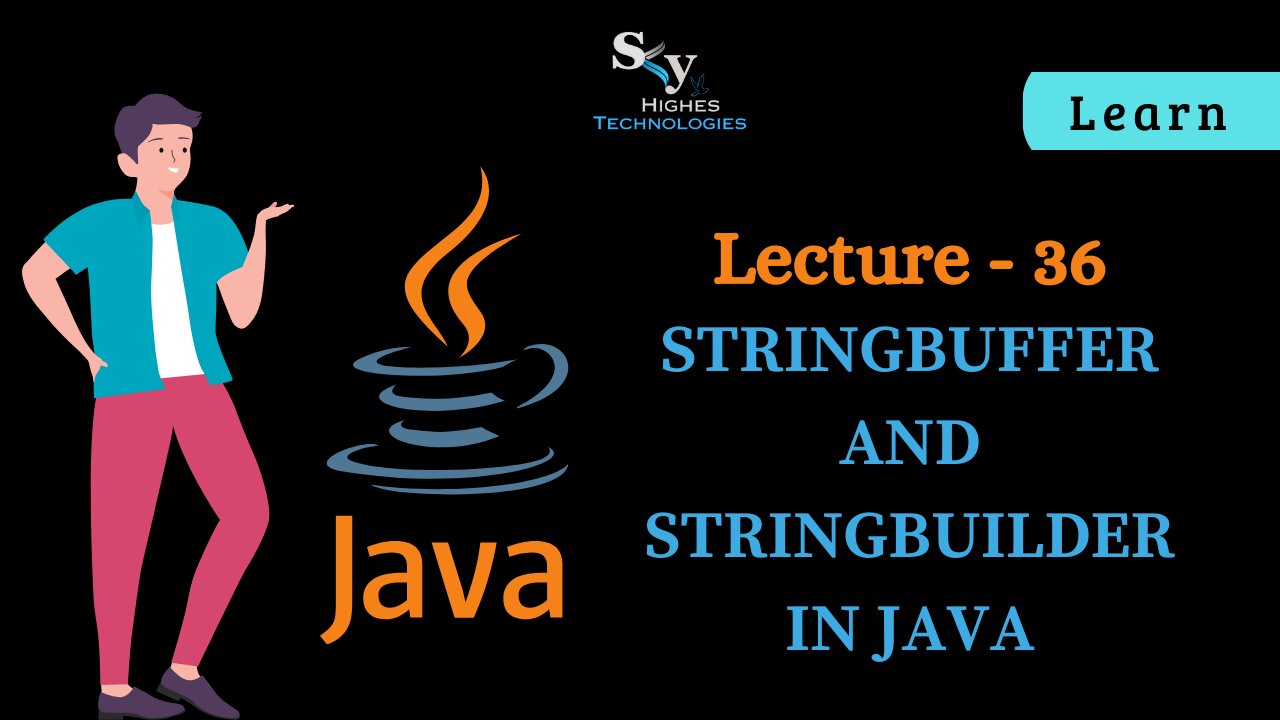Premium Only Content

#36 String Buffering and String Building in JAVA | Skyhighes | Lecture 36
Here's a comprehensive explanation of string buffering and string building in Java:
String Buffering with StringBuilder:
Mutable: Strings created with StringBuilder can be modified after creation.
Efficient for frequent modifications: Ideal for scenarios where you'll be repeatedly appending, inserting, or deleting characters within a string.
Thread-safe: StringBuilder is not thread-safe, meaning operations on it from multiple threads without synchronization can lead to unexpected results.
Key Methods:
append(String str): Appends a string to the end.
insert(int offset, String str): Inserts a string at a specified index.
delete(int startIndex, int endIndex): Deletes a portion of the string.
toString(): Returns the current string representation.
Example:
Java
StringBuilder sb = new StringBuilder("Hello");
sb.append(", world!"); // sb now contains "Hello, world!"
sb.insert(7, "beautiful "); // sb now contains "Hello, beautiful world!"
Use code with caution. Learn more
String Building with StringBuffer:
Also mutable: Like StringBuilder, strings created with StringBuffer can be modified.
Thread-safe: StringBuffer is thread-safe, making it suitable for multithreaded environments.
Less efficient: Due to thread-safety measures, StringBuffer is generally less efficient than StringBuilder for single-threaded operations.
Key Methods:
Same methods as StringBuilder: StringBuffer shares the same core methods with StringBuilder.
Choosing the Right Class:
StringBuilder: Use for single-threaded scenarios where efficiency is a priority.
StringBuffer: Use in multithreaded environments where thread safety is essential.
Key Points:
Both StringBuilder and StringBuffer are more efficient than using the + operator for string concatenation when dealing with frequent modifications.
The toString() method is crucial for obtaining the final string value from either class.
Additional Considerations:
Consider using Java's newer StringJoiner class, introduced in Java 8, for efficient and readable string concatenation.
-
 2:56:12
2:56:12
TimcastIRL
4 hours agoTrump SLAMS Democrats Over Irina Zarutska Killing, Says WAR Over Chicago Crime | Timcast IRL
149K89 -
 29:08
29:08
Afshin Rattansi's Going Underground
1 day agoCol. Lawrence Wilkerson: World War 3 is ALREADY HERE, Netanyahu is INTENT on Greater Israel
10K21 -
 LIVE
LIVE
SpartakusLIVE
6 hours agoNONSTOP Snipes, Rockets, and BICEPS = Monday MOTIVATION
495 watching -

Rallied
7 hours ago $0.39 earnedSolo Challenges All Day
42.4K2 -
 1:27:53
1:27:53
Flyover Conservatives
9 hours agoIs AI Actually Alien Intelligence? Dr. Jason Dean Exposes the Dark Side | FOC Show
21.9K -
 1:47:36
1:47:36
Glenn Greenwald
6 hours agoJD Vance and Rand Paul Clash on Due Process: War on Terror Echoes; Has the U.S. Given Up on Confronting China? Ben Shapiro's Latest Falsehoods About Israel | SYSTEM UPDATE #510
93.2K67 -
 LIVE
LIVE
RaikenNight
4 hours ago $0.39 earnedExploring the Galaxy of No Mans Sky
210 watching -
 LIVE
LIVE
Spartan
5 hours agoRanked and Expedition 33 (NG+4 and all enemies Set to 10x health)
84 watching -
 2:54:31
2:54:31
Jokeuhl Gaming and Chat
9 hours agoDARKTIDE - Warhammer 40k w/ Nubes and AoA
11.9K1 -
 2:19:56
2:19:56
Nerdrotic
15 hours ago $1.07 earnedNerdrotic Nooner 513
46.2K2